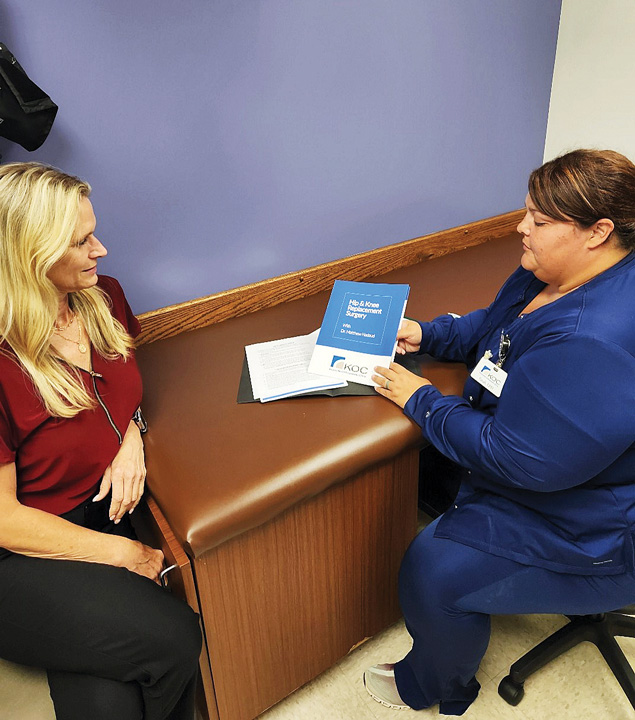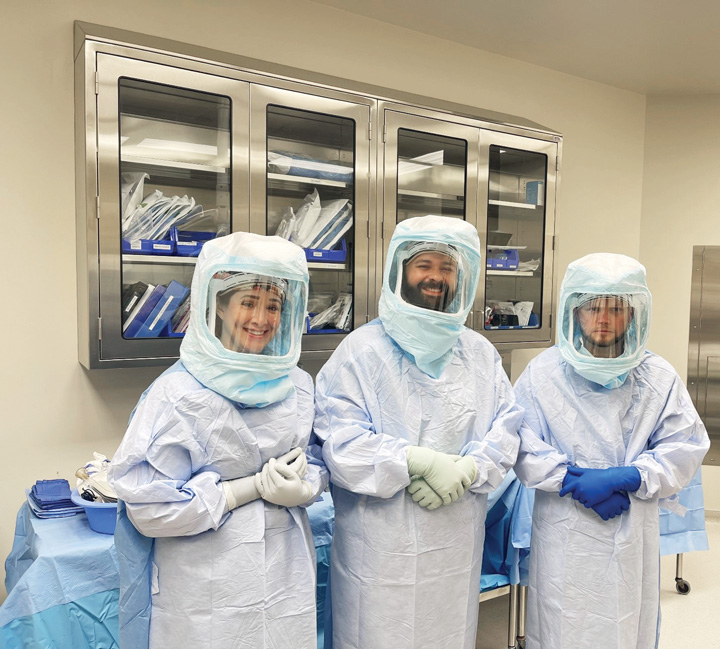- Home
- Article
Key Metrics of a Successful Total Joints Program
By: Jennifer Parrott, RN | Contributing Editor
Published: 9/16/2024
Selecting the right patients allows providers to deliver efficient care in this surging service line.
If your facility performs total joints or is considering doing so, how should you measure success?
Standards at KOSC
Knoxville (Tenn.) Orthopaedic Surgery Center (KOSC), where I work, started performing total joints in 2017. We added two ORs in 2019 and have ramped up our volume steadily ever since. Performing a high volume of procedures is important. For instance, Matthew Nadaud, MD, an orthopedic surgeon who performs total hip and total knee arthroplasties as well as partial knee replacements, performed more than 400 total joints procedures at KOSC last year.
After interviewing several disciplines within Knoxville Orthopedic Group, I discovered the most important metrics and protocols were generally universal: patient satisfaction rates, patient education, staffing levels, cost controls, average case times, infection rates, patient readmission rates and having an Enhanced Recovery After Surgery (ERAS) protocol.
Efficiency reigns

When evaluating the effectiveness of your joints program, procedure time form start to finish is of the essence. Average length of stay depends on many factors, but the biggest one for success is how well the patient recovers immediately after the procedure and can be discharged safely and quickly. This is why it is extremely important to have a ERAS program in place. In addition to the education performed prior to surgery, patients need to know what to expect and to embrace the expectations that are placed on them.
“We follow hip and knee scores (HOOS/KOOS), but to me the most important measures are maintaining a low complication rate and specifically a low infection rate. Second, drive to have excellent patient satisfaction. I feel those parameters outweigh any score,” explains Dr. Nadaud. “As a program, we strive for similar results to gauge our success, as well as the steps we take to gain additional accreditation such as national rankings and center-of-excellence designations.”
ERAS is essential
This multidisciplinary approach focuses on preoperative, intraoperative and postoperative care of the patient. ERAS protocols are evidence-based practices that focus on each patient’s needs and expectations. ERAS-influenced standardization can also decrease cost and waste, which is beneficial to the patient and the facility. Standardized care prevents items and supplies from being opened when they are not needed, prevents the patient from being charged for items not used and prevents the facility from accruing higher costs.
Patient education

Years ago, patient education was primarily performed at discharge. Health care has shifted, however, and patient education is now at the forefront of all successful programs. For a successful outpatient total joints program, patient education begins with the patient’s first visit and continues after discharge. According to Renee Garland, one of our charge nurses, “Education molds patients’ understanding and expectations of the entire preoperative, surgical and recovery process. It’s invaluable in relieving preoperative anxiety and preparing patients for a successful recovery.” Renee and her team work closely with the clinics to obtain vital patient information prior to the date of the patient’s surgery. All patients have similar questions such as, “What does the process look like? What will it entail? What am I to do? What about physical therapy? What about my family? How will this affect them?”
When confronted with these questions, our staff distributes informational booklets that contain many of the answers, according to Sarah Tefetellar, a primary nurse for one of KOSC’s surgeons. Each patient also attends a total joints class that is vital to their success. The class consists of hands-on teaching about the dos and don’ts, with in-depth instructions on what their physical therapy will entail. Brigina Wilkerson, a physician therapist with the KOSC group, says spending time with patients preoperatively is vital. “We want to not only know the patient fully understands how to utilize their assistive device but we want to see it,” she says. “This is as equally important as the exercises.”
Patient education will boost your patient satisfaction rates. When healthcare workers take the time to teach and connect one-on-one with a patient, this resonates and is one of your most valuable assets.
• Patient selection. Our pre-admission nurse is responsible for communicating with the patient to discern if they meet our selection criteria. We utilize a standardized patient selection questionnaire that is located in our electronic charting system. The development of the questionnaire was a cumulative effort between nurses and anesthesia. Patients do not get approved for total joint surgery unless they meet all our criteria. For example, for our total joint patients, BMI cannot exceed 45. We also discern if the patient is diabetic. If they are, is it under control? In order to get a better picture of the patient’s lab values, we request their hemoglobin A1C. In addition, we take anemia into account. We need to find out if the patient is anemic and, if so, are their values less than 10? If the answer is yes, then they cannot have surgery at the ASC.
The most important measures are maintaining a low complication rate, specifically, a low infection rate.
Matthew Nadaud, MD
In addition to this exclusion criteria, a patient will not be a candidate for surgery if they have a history of malignant hyperthermia or any other comorbidities that place them into an ASA IV classification. In addition, we take patients’ current illnesses into account. This includes a history of COVID-19 or excessive alcohol, tobacco or drug consumption. We also factor in the medications they are currently taking and whether they have a history of difficult intubation.
Infection rates
This term is considered blasphemous within the healthcare setting. Healthcare organizations are required to track patient infection rates, but what do you do with those numbers? Do you look at the data purely as a number or do you look at it as something to improve upon? How does your ASC track infection rates? In order for an organization to have a successful total joints program, a strong quality improvement process needs to be in place. When an infection arises, do you have a process in place or a team to investigate this and see if there were any breakdowns along the way? Do you have a team in place to correct those deficiencies? Are you benchmarking your data against other facilities? Even the most successful facilities do not want to focus on the negative outcomes, but if you only focus on what is done correctly, how will you ever grow and be successful? In order to be successful, you must always strive to improve. Growth can be uncomfortable.
Highly trained and specialized staff
Organizations must employ specialized preoperative, intraoperative and postoperative staff with the understanding that this is imperative for an effective and successful total joints program. Employing trained and qualified staff allows an ASC to generate greater volume that can increase profit, reduce turnover rates and reduce complications by anticipating problems decrease infection rates. “Staff must be comfortable with pre-op care, recognizing surgical site or anesthetic complications, and be prompt in responding to rapid changes,” notes Ms. Garland. By investing in your employees and training them effectively, you can create a successful total joints program.
The Hip Dysfunction and Osteoarthritis Outcome Score (HOOS) and Knee injury and Osteoarthritis Outcome Score (KOOS) surveys have long been used by total joints surgeons as a relevant outcome-measuring tool. However, Hospital for Special Surgery (HSS) has developed a shorter, modified version of the original survey dubbed HOOS, JR. and KOOS, JR. The best part? The forms are nonproprietary and free to use. Want to see if the tool is right for your total joints program? The forms and instructions are available at osmag.net/totaljointforms.
Source: HSS
How does a total joints program ensure continued success? Think about your ultimate goal. Each and every patient wants an engaging and successful experience. How can your organization make this happen? Communication and collaboration among multiple disciplines is vital to ensure a successful total joints program. From technology to resources, do the research, perform the education, implement policies and procedures and, lastly, network with your peers. Do not be afraid to ask for help or advice. Everyone needs advice at some point. Do not get complacent. Never stop learning and growing. Familiarity is your worst enemy. OSM
.svg?sfvrsn=be606e78_3)
.svg?sfvrsn=56b2f850_5)